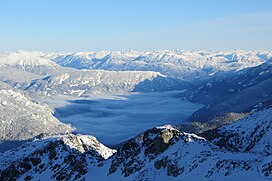
Back سلاسل جبال ساحل المحيط الهادئ Arabic Cadena costera del Pacíficu AST Яр буйы һырттары Bashkir Берагавыя хрыбты Byelorussian Брегови хребети Bulgarian Pacific Coast Ranges Catalan Pobřežní pásmo Czech Pazifische Küstengebirge in Nordamerika German Pacifika Montaro Esperanto Cadena costera del Pacífico Spanish
| Pacific Coast Ranges | |
|---|---|
 Canadian Coast Range, Whistler, British Columbia | |
| Highest point | |
| Peak | Mount Logan |
| Elevation | 5,959 m (19,551 ft) |
| Dimensions | |
| Length | 3,800 mi (6,100 km) |
| Geography | |
 | |
| Countries |
|
| Parent range | North American Cordillera |

The Pacific Coast Ranges (officially gazetted as the Pacific Mountain System[1] in the United States; French: chaînes côtières du Pacifique; Spanish: cadena costera del Pacífico)[2] are the series of mountain ranges that stretch along the West Coast of North America from Alaska south to Northern and Central Mexico. Although they are commonly thought to be the westernmost mountain range of the continental United States and Canada, the geologically distinct Insular Mountains of Vancouver Island lie farther west.
The Pacific Coast Ranges are part of the North American Cordillera (sometimes known as the Western Cordillera, or in Canada, as the Pacific Cordillera and/or the Canadian Cordillera), which includes the Rocky Mountains, the Columbia Mountains, the Interior Mountains, the Interior Plateau, the Sierra Nevada, the Great Basin mountain ranges, and other ranges and various plateaus and basins.
The Pacific Coast Ranges designation, however, only applies to the Western System of the Western Cordillera,[3] which comprises the Saint Elias Mountains, Coast Mountains, Insular Mountains, Olympic Mountains, Cascade Range, Oregon Coast Range, California Coast Ranges, Transverse Ranges, Peninsular Ranges, and the Sierra Madre Occidental.
- ^ Physiographic regions of the United States, USGS
- ^ Merriam-Webster's collegiate encyclopedia, page 361 (Merriam-Webster, 2000).
- ^ S. Holland, Landforms of British Columbia, BC Govt. 1976.